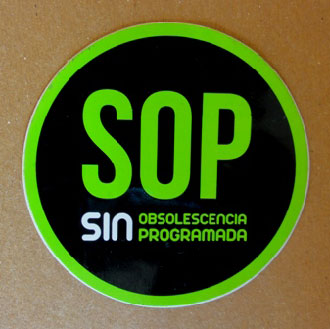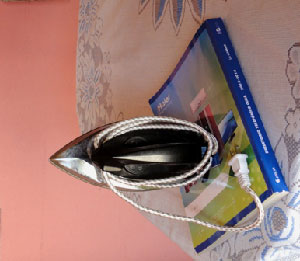Cuba and Planned Obsolescence
Daisy Valera

HAVANA TIMES — If memory serves me right, the first electrical appliances I ever used were the Orbita fan which afforded me a cool night’s sleep the few nights without power cuts, the iron that smoothed out all of the uniforms I ever had to wear (from primary to high school) and a green Aurika washing machine which always looked on the verge of falling apart when tumbling clothes dry – and always, incidentally, remained in one piece.
Many of these appliances, manufactured in the former Soviet Union over 30 years ago, continue to be used in Cuban homes. “Russian irons” continue to be repaired at workshops and the metallic jars for the Soviet-made Eta blenders continue to be produced at street-level.
It comes as no surprise that, during the flamboyant “Energy Revolution” Cuba undertook in the early 2000s, many people who owned Frigidaire-brand refrigerators or air conditioning units made in the USSR, refused to trade these in for their new Chinese counterparts.
Not long after these replacements were made, some of the appliances which have been roughing it for decades conserve their aura of immortality, while the modern Haier refrigerators and Liya rice cookers pile up like junk at repair shops and warehouses.
Today, Cubans are becoming accustomed to the disposable and fragile nature of a new generation of electrical appliances and begin to feel pangs of nostalgia for the times of durable – and repairable – devices.
It is within this context, a world governed by the buy-throw-away-buy-again logic, that the SOP (“Sin Obsolescencia Programada”, “No Planned Obsolescence”) movement arises. Planned obsolescence, a concept that is almost entirely new to Cubans, refers to the practice of deliberately producing short-durability objects in order to keep consumers purchasing new products.
 Though “consumerism” is not one of the more serious ills endured by a country with constant shortages, planned obsolescence affects the lives of Cubans for two fundamental reasons:
Though “consumerism” is not one of the more serious ills endured by a country with constant shortages, planned obsolescence affects the lives of Cubans for two fundamental reasons:
— The appliances sold in the country are not manufactured locally, but imported.
— Cubans earn ridiculously low wages.
A Cuban earning an average salary (450 Cuban pesos a month) would need to put away his entire wages, every month for over two years, to be able to purchase an iron, a blender and a TV (about 20, 50 and 400 CUC, respectively) at a hard-currency store.
This fact alone makes the abovementioned, short-lived electrical appliances irreplaceable treasures in Cuba.
The SOP movement, impelled by Spanish engineer Benito Muros, aims to sell products that aren’t designed to have a short lifespan and are environmentally-friendly, drastically reducing the volumes of waste materials produced by today’s modern products.
Muros’ company, OEP Electrics, has created a light bulb “without planned obsolescence” that has a guaranteed lifespan of 25 years and can be repaired and reused indefinitely. In addition, the light bulb saves up to 92 % in electricity and produces 70 % less carbon dioxide.
If the Cuban State is at all interested in an energy revolution that actually yields results, it should lend an ear to the SOP movement and do away with Cuba’s so-called energy-saving bulbs, electrical stoves and fearsome Parker brand DVD players.
A positive first step, for instance, would be to build a plant for the manufacturing of Muros’ bulbs on the island.

Great post, Daisy. There’s a company in the US called CREE that makes LED light bulbs, in the 40 and 60 watt-equivalent sizes. With California sales tax, they cost around $18 to $24, respectively. They are sold in the Home Depot stores. They give good light and, over time, should save hundreds of dollars in electricity costs.
I’ve replaced most of my mercury-laden CFLs with them, and am very satisfied. The higher price is a lump in the throat, but it seems worth it to save money in the long run, protect the environment, and support a new and better technology.
One problem is that they do not offer a 100 watt-equivalent bulb, which is what I’d truly like to use to brighten-up the place. Perhaps we will change our lamps to two-headed fixtures.
We have a Maytag refrigerator that’s over twenty-years-old. The damned, electricity-sucking thing just will not die and force us to purchase a new, energy-efficient one!
Planned obsolescence is a pisser, and it is everywhere. Cheers.
Daisy…Hemingway On Stage agrees with you. You are invited to a live performance of HEMINGWAY’S HOT HAVANA on June 21, 8 PM at the Hotel Palacio O’Farrill as a complimentary guest. Live theatre is never obsolete.
Great post Daisy! I have long been disgusted by planned obsolescence. I hope movements like SOP will take root in many countries.
The long-life, reparable lightbulb you mention is particularly intriguing. I have read that this is a type of LED light, which consumes very little energy.
In many countries, there has been a push to switch from incandescent bulbs to compact florescents, due to the energy savings. In the long run, however, I do not think this truly benefits the environment because the florescent bulbs contain mercury, which is hazardous.
It would be wonderful if Cuba would start manufacturing Muros’ bulb. I hope project like that will be possible!
This same Murros was threatened with death because his research team developed a light bulb that supposedly does not wear out:
“Señor Muros, usted no puede poner en el mercado sus sistemas de iluminación. Usted y su familia serán aniquilados”
http://www.eleconomista.es/hpymes/noticias/4290506/10/12/Me-persiguen-por-crear-una-bombilla-que-no-se-funde.html
In my childhood, if a product was stamped ‘Made in China’, that meant it was an inexpensive and cheaply-made version of a similar product made in the US or elsewhere. This is no longer the case but China continues to sell a large number of low quality products, especially to Third World consumers like Cuba. For economic reasons, the Cuban consumer has less access to medium and high quality electrical appliances because of the medium and high quality price tags that accompany those appliances. The US embargo has little to do with this problem. The Cuban government imposes a 240% import tax on ‘big ticket’ foreign-made appliances. Product marketing, which in most countries adds millions of dollars to the cost to the consumer is non-existent in Cuba. For example, the reality that new better quality flat-screen TVs or laptop computers sold in Cuba are double or nearly triple the costs of identical products sold in the US is simply due to volume buying discounts and the inexplicable Cuban import tax.